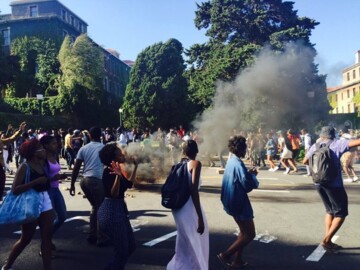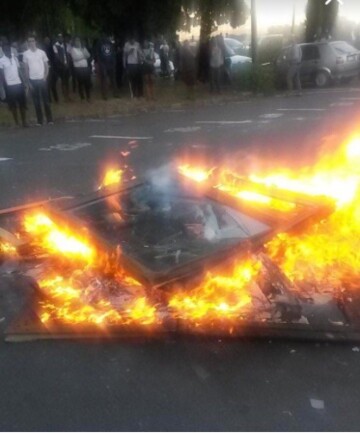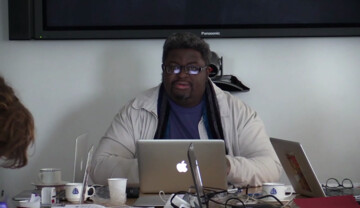When I was in my teens activists in our communities took to re-naming their neighbourhoods after cities and countries that had supported the anti-apartheid struggle. Moscow, Tanzania, Lusaka, etc. These activists, who were known collectively as “amaqabane” or “comrades” exercised a lot of influence over sections of black communities that were sympathisers of then banned liberation movement the African National Congress (ANC). In the turbulent 1980s, as the fight against apartheid reached its peak, the comrades would frequently call for and enforce school boycotts and stay-aways as strategies of resisting apartheid. Sometimes their methods of enforcement were violent, but it was also understood that their call to make South Africa’s unjust system “ungovernable” would be crucial to attaining freedom.
I highlight this history for two reasons. Firstly, I wish to point to the fact that the idea of renaming was very much about reclaiming space and about carving out a different sense of identity. Secondly, I want to note that symbolic and creative acts of resistance were part of a larger struggle that included more militant methods that, though at times disturbing, had to be understood first and foremost within the context of a brutal and illegitimate apartheid state.
Although South Africa is often lauded for its peaceful transition to democracy, my experience of the late 1980s and early 1990s was anything but peaceful. Perhaps unlike other anti-colonial struggles, which were characterised by periods of intense fighting, ours was a long drawn out conflict – what has often been termed a low-intensity civil war. But whatever one might name it that period in our history – peaceful it was not. In that sense our liberation struggle was not much different to any other on the African continent nor any other struggle for → self-determination elsewhere in the world. Furthermore, our state and its cultural institutions are themselves products of that conflict. It is now an often-forgotten fact that modern museums were formed in the crucible of the French Revolution. When we experience museums in the present it is easy to forget that the museum and the guillotine share a common ancestry. Whereas social and political upheavals imply plurality of expression, statecraft requires bureaucratisation and formalisation. In the South Africa of the post-1994 era contestation over the authorship of the liberation narrative has resulted in the narrowing of this plurality into a singular narrative.
What has emerged in the days since the advent of democracy is a sophisticated industry of heritage professionals and specialists in the arena of memory work, which includes public art, memorials, monuments, museums and commemorations. Unsurprisingly the sectors of society that had been the beneficiaries of privilege in the past have been at the forefront of the memory industry. The fact that the government that was formed after 1994 opted to keep and maintain the majority of the museums and monuments that had been erected at the time of colonial and apartheid rule, in keeping with the “sunset clauses” of the negotiated settlement and transition to democracy, was an early signal that the long-anticipated → emancipation would be of a significantly different nature to the one we, the oppressed, had hoped for. The rationale was that in order for the tenuous peace to succeed the beneficiaries of oppression needed to be reassured that there would be a place for them in the new South Africa, and that there would not be any retaliatory treatment after the transition to majority rule. Insofar as museums and memorials are deeply implicated in statecraft and corporatism, these have to a large extent alienated large sections of the black poor who still experience economic, cultural and social exclusion from the fruits of democracy, and by extension museums of the post-apartheid era.
It is therefore ironic that such systematic exclusion should exist in a context where the overarching narrative of the post-1994 state and its constitution is one of inclusivity – i.e. that it is a state, which embraces everybody, both the beneficiaries and victims of colonialism and apartheid. The institutions of state reflected this narrative of inclusivity. This is what is often described internationally as the South African miracle. As a result, we have a situation in which the monuments that celebrated colonial and apartheid heroes exist side-by-side with newer monuments that chronicle the anti-apartheid struggle. In some cases institutions that represented oppression were converted into new ones, including Constitution Hill, which was once a prison and now houses the constitutional court and a museum, and you also have the Robben Island Museum where Mandela and other political prisoners were held. Other such sites are dotted around the country. The historian Annie Coombes argues that this strategy has rehabilitated these institutions from being places of → pain to places of reconciliation.
In post-1994 South Africa, heritage and heritage professionals have been enlisted in service of a post-apartheid nation-building narrative. This grand narrative focuses on certain individuals, sites and stories in order to provide, and not necessarily in a cynical manner, precisely the grounds on which the moral right to rule is founded. The means of remembering were fashioned into state rituals, personalities were canonised and sites of memory institutionalised. A bureaucracy has been mobilised to make official what was once visceral. In many instances it was as if history stopped in 1994.
Professor Mahmood Mamdani, in an essay titled “African Intellectuals and Identity: Overcoming the Political Legacy of Colonialism”, argues that the existence of civil society depends on the monopolisation of the means of violence by the state. If we take for granted that the right to govern is justified by a nation’s founding myths and that this right is guaranteed not just by popular support, but also by institutionalisation and coercion, then we can conclude that the stability of the nation-building mission relies on the one hand on more benign forms of “manufacturing consent”[1] such as museums but also on more coercive dimensions of state machinery. One of the more vexing questions that South African civil society faces at the moment is: what happens when the populist measures of enlisting support for the regime no longer hold sway over the public imagination?
The recent calls for the → decolonisation of South African universities, led by the #RhodesMustFall (RMF) and #FeesMustFall (FMF) movements, have reinvigorated debates around memorial culture and represent the most visceral challenge to the bureaucratisation of memory since the dawn of the South African democratic state. In a move reminiscent of the “comrades” of my youth in the 1980s and early 1990s, the current crop of youth activists has also taken to renaming certain university buildings after heroes of the anti-apartheid struggle, such as Solomon Mahlangu. With their battle cry “Everything Must Fall”, the youth of today also draw from the preceding generations’ slogan of making South Africa “ungovernable”.
The language of protest never quite left the South African landscape. Broadly speaking, public speech in the post-1994 moment is characterised by three currents: one being a corporatist media-driven messaging which is heavily peppered with the gospel of prosperity and consumption, and reinforced by celebrity culture. The second being the statist discourse which speaks variously and sometimes in contradictory languages of the rule of law, freedom, social cohesion, social justice, constitutionalism, nation-building, and so on. In this category I would also include various institutions of civil society, such as → lobby groups, certain sections of the media, NGO’s, the academy, think tanks, and the like. The reason for this being that although the state, or more specifically the government, may at times differ in terms of policy with some of these institutions, the dominant discourse remains one of constitutionalism and the belief that the way to solve social issues is through the organs of the state, such as the judiciary and the electoral system. Bureaucracy, protocol and expert-language are the touchstones of this form of public speech. A third form of public speech is the language of protest. In contrast to the former two, this is the language of the powerless. Its intention is to disrupt, and at times violently so.
Typically, these protests have been about increases in wages for workers, the provision of water, electricity and sanitation, calls for an end to evictions, and, in more recent years, student protests over increases in the cost for higher education. Insofar as this form of public speech is taking place in a democratic system, and insofar as it is motivated by the fact that poor people do not have the same access to state organs and to the corporate-driven media, it brings into focus questions that had been asked by Professor Achille Mbembe in his book On the Postcolony: “Who is to be protected, by whom, against what and whom, at what price? [...] When may one cease to obey authority without punishment?”
The RMF movement began early in 2015 in Cape Town, when a student at the University of Cape Town, Chumani Maxwele, poured excrement on the statue of Cecil John Rhodes that was situated on the university grounds. The movement quickly grew to include other issues of racism on the university, and included a demand for the decolonisation of the curriculum.
Later on in 2015, protests at various campuses across the country erupted when it was announced that student fees would be increased by 10 percent, thus giving birth to the FMF movement with a demand for free education. Both the RMF and FMF movements were concerned with the systematic and economic exclusion of black students by the education system. In the course of those struggles students attacked symbols of a history they felt represented their exclusion, including Rhodes himself. More controversially, in 2016 students at UCT burned paintings of previous university chancellors. Many in our society have drawn a sharp line between what they feel are legitimate student demands on the one hand, and destructive tactics on the other. Many argued that the angry and disruptive protests were in violation of the rights of other students and staff members, and several times students were arrested then released.
The language of non-racialism is now being replaced with that of anti-racism. There is a growing sense that by de-emphasising the issue of race the government and the older generation of activists have sought to assimilate into the dominant white society, and thus a feeling that there has been a political and generational betrayal.
The → decolonial movement has not only been about material demands nor has it only been about symbolism, but also about altering the language of politics and most significantly changing the culture of doing politics. This has meant undermining the prevailing deference to age and political experience, which is widely read by preceding generations of activists as disrespect. Well-meaning and concerned anti-apartheid struggle veterans who have offered guidance and parental advice have been shouted down and booed by the current crop of students. Even celebrities have been denied a platform to speak at RMF and FMF rallies. These groups have insisted that the rest of society engage with them on their own terms.
The question now is what is next? Where will all this lead? In terms of museum practice there certainly seems to be little or no acknowledgement that a seismic shift is taking place in the arena of collective memory. If they are to remain relevant universities and other cultural institutions will have to find ways of dealing with changing times, and it remains to be seen if museum professionals do have the will to “commit class suicide”[2] and decolonise in line with the urgent need for social transformation that is upon us.





